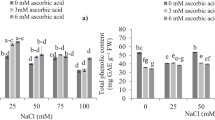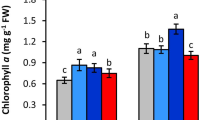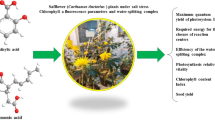Abstract
Water scarcity is one of the main factors limiting crop production worldwide. The study on response of saffron to irrigation regime showed that one-time irrigation at field capacity of 100% resulted in the greatest number and weight of flower, and dry stigma yield, but weekly irrigation regime at the same conditions prevented flowering process. One-time irrigation regime reduced water potential (Ψw) of plants, while the contents of chlorophylls, carotenoid, anthocyanin, carbohydrates, phenol, amino acid, proline, H2O2, and the activity of antioxidant enzymes in the one-time irrigated plants were higher than in the weekly irrigated plants. The nitric oxide (NO) donor, sodium nitroprusside (SNP), significantly increased photosynthetic and non-photosynthetic pigments, metabolites, and antioxidants in both irrigation regimes, with the highest content in the one-time irrigated plants. The SNP treatment increased the flower yield in the one-time irrigated plants, but it could not induce flowering in the weekly irrigated plants. Collectively, these results demonstrated the importance of irrigation regime in flower induction in saffron. Even though the exogenous SNP improved the performance of saffron, it could not overcome the importance of irrigation frequency regime on flowering process. Overall, the SNP application accompanied with the one-time irrigation regime provided higher flower yield and improved the physiological performance of saffron plant.




Similar content being viewed by others
Abbreviations
- APX:
-
Ascorbate peroxidase
- CAT:
-
Catalase
- Chl:
-
Chlorophyll
- FRAP:
-
Ferric reducing antioxidant power
- LDM:
-
Leaf dry mass
- LFM:
-
Leaf fresh mass
- LWC:
-
Leaf water content
- H2O2 :
-
Hydrogen peroxide
- MDA:
-
Malondialdehyde
- NO:
-
Nitric oxide
- ROS:
-
Reactive oxygen species
- RS:
-
Reducing sugar
- SNP:
-
Sodium nitroprusside
- SOD:
-
Superoxide dismutase
- WSC:
-
Water-soluble carbohydrates
References
Aebi H (1984) Catalase in vitro. Method Enzymol 105:121–126
Ahanger MA, Aziz U, Alsahli AA, Alyemeni MN, Ahmad P (2020) Influence of exogenous salicylic acid and nitric oxide on growth, photosynthesis, and ascorbate-glutathione cycle in salt stressed Vigna angularis. Biomolecules 10(1):42
Ahmad P, Abdel Latef AA, Hashem A, Abd_Allah EF, Gucel S, Tran L-SP (2016) Nitric oxide mitigates salt stress by regulating levels of osmolytes and antioxidant enzymes in chickpea. Front Plant Sci 7:347
Ahmad P, Abass Ahanger M, Nasser Alyemeni M, Wijaya L, Alam P, Ashraf M (2018a) Mitigation of sodium chloride toxicity in Solanum lycopersicum L. by supplementation of jasmonic acid and nitric oxide. J Plant Interact 13(1):64–72
Ahmad P, Ahanger MA, Alyemeni MN, Wijaya L, Alam P (2018b) Exogenous application of nitric oxide modulates osmolyte metabolism, antioxidants, enzymes of ascorbate-glutathione cycle and promotes growth under cadmium stress in tomato. Protoplasma 255(1):79–93
Asada K (1992) Ascorbate peroxidase–a hydrogen peroxide-scavenging enzyme in plants. Physiol Plant 85(2):235–241
Bai X, Yang L, Yang Y, Ahmad P, Yang Y, Hu X (2011) Deciphering the protective role of nitric oxide against salt stress at the physiological and proteomic levels in maize. J Proteome Res 10(10):4349–4364
Barbieri G, Vallone S, Orsini F, Paradiso R, De Pascale S, Negre-Zakharov F, Maggio A (2012) Stomatal density and metabolic determinants mediate salt stress adaptation and water use efficiency in basil (Ocimum basilicum L.). J Plant Physiol 169(17):1737–1746
Basu S, Ramegowda V, Kumar A, Pereira A (2016) Plant adaptation to drought stress. F1000Research. https://doi.org/10.12688/f1000research.7678.1
Bates L, Waldren R, Teare I (1973) Rapid determination of free proline for water-stress studies. Plant Soil 39(1):205–207
Beauchamp C, Fridovich I (1971) Superoxide dismutase: improved assays and an assay applicable to acrylamide gels. Anal Biochem 44(1):276–287
Bi Y, Zhang J, Song Z, Wang Z, Qiu L, Hu J, Gong Y (2019) Arbuscular mycorrhizal fungi alleviate root damage stress induced by simulated coal mining subsidence ground fissures. Sci Total Environ 652:398–405
Bodner G, Nakhforoosh A, Kaul H-P (2015) Management of crop water under drought: a review. Agron Sustain Dev 35(2):401–442
Bradford MM (1976) A rapid and sensitive method for the quantitation of microgram quantities of protein utilizing the principle of protein-dye binding. Anal Biochem 72(1–2):248–254
Du Y, Zhao Q, Chen L, Yao X, Zhang W, Zhang B, Xie F (2020) Effect of drought stress on sugar metabolism in leaves and roots of soybean seedlings. Plant Physiol Biochem 146:1–12
DuBois M, Gilles KA, Hamilton JK, Pt R, Smith F (1956) Colorimetric method for determination of sugars and related substances. Anal Chem 28(3):350–356
Farooq M, Wahid A, Kobayashi N, Fujita D, Basra SMA (2009) Plant drought stress: effects, mechanisms and management. Agron Sustain Dev 29:185–212
Flurkey WH, Jen JJ (1980) Purification of peach polyphenol oxidase in the presence of added protease inhibitors. J Food Biochem 4(1):29–41
Ghorbani R, Koocheki A (2017) Sustainable cultivation of saffron in Iran. In: Lichtfouse E (ed) Sustainable agriculture reviews. Springer, New York, pp 169–203
Golmohammadi F (2014) Saffron and its farming, economic importance, export, medicinal characteristics and various uses in South Khorasan Province-East of Iran. Int J Farm Appl Sci 3(5):566–596
Guo Y-Y, Yu H-Y, Kong D-S, Yan F, Zhang Y-J (2016) Effects of drought stress on growth and chlorophyll fluorescence of Lycium ruthenicum Murr. seedlings. Photosynthetica 54(4):524–531
Hajihashemi S, Ehsanpour AA (2013) Influence of exogenously applied paclobutrazol on some physiological traits and growth of Stevia rebaudiana under in vitro drought stress. Biologia 68(3):414–420
Hajihashemi S, Ehsanpour AA (2014) Antioxidant response of Stevia rebaudiana B. to polyethylene glycol and paclobutrazol treatments under in vitro culture. Appl Biochem Biotechnol 172(8):4038–4052
Hajihashemi S, Sofo A (2018) The effect of polyethylene glycol-induced drought stress on photosynthesis, carbohydrates and cell membrane in Stevia rebaudiana grown in greenhouse. Acta Physiol Plant 40(8):142
Hajihashemi S, Noedoost F, Geuns JMC, Djalovic I, Siddique KHM (2018) Effect of cold stress on photosynthetic traits, carbohydrates, morphology, and anatomy in nine cultivars of Stevia rebaudiana. Front Plant Sci 9:1430. https://doi.org/10.3389/fpls.2018.01430
He Y, Tang R-H, Hao Y, Stevens RD, Cook CW, Ahn SM, Jing L, Yang Z, Chen L, Guo F (2004) Nitric oxide represses the Arabidopsis floral transition. Science 305(5692):1968–1971
Heath RL, Packer L (1968) Photoperoxidation in isolated chloroplasts: I. Kinetics and stoichiometry of fatty acid peroxidation. Arch Biochem Biophys 125(1):189–198
Kafi M, Koocheki A, Rashed M (2006) Saffron (Crocus sativus): production and processing. Science Publishers, New York
Kalaji HM, Jajoo A, Oukarroum A, Brestic M, Zivcak M, Samborska IA, Cetner MD, Łukasik I, Goltsev V, Ladle RJ (2016) Chlorophyll a fluorescence as a tool to monitor physiological status of plants under abiotic stress conditions. Acta Physiol Plant 38(4):102
Kaya C (2020) Nitrate reductase is required for salicylic acid-induced water stress tolerance of pepper by upraising the AsA-GSH pathway and glyoxalase system. Physiol Plant. https://doi.org/10.1111/ppl.13153
Kaya C, Tuna L, Higgs D (2006) Effect of silicon on plant growth and mineral nutrition of maize grown under water-stress conditions. J Plant Nutr 29(8):1469–1480
Kaya C, Ashraf M, Wijaya L, Ahmad P (2019a) The putative role of endogenous nitric oxide in brassinosteroid-induced antioxidant defence system in pepper (Capsicum annuum L.) plants under water stress. Plant Physiol Biochem 143:119–128
Kaya C, Okant M, Ugurlar F, Alyemeni MN, Ashraf M, Ahmad P (2019b) Melatonin-mediated nitric oxide improves tolerance to cadmium toxicity by reducing oxidative stress in wheat plants. Chemosphere 225:627–638
Kaya C, Akram NA, Ashraf M, Alyemeni MN, Ahmad P (2020a) Exogenously supplied silicon (Si) improves cadmium tolerance in pepper (Capsicum annuum L.) by up-regulating the synthesis of nitric oxide and hydrogen sulfide. J Biotechnol 316:35–45
Kaya C, Ashraf M, Alyemeni MN, Ahmad P (2020b) Nitrate reductase rather than nitric oxide synthase activity is involved in 24-epibrassinolide-induced nitric oxide synthesis to improve tolerance to iron deficiency in strawberry (Fragaria× annassa) by up-regulating the ascorbate-glutathione cycle. Plant Physiol Biochem 151:486–499
Kaya C, Ashraf M, Alyemeni MN, Ahmad P (2020c) Responses of nitric oxide and hydrogen sulfide in regulating oxidative defence system in wheat plants grown under cadmium stress. Physiol Plant 168(2):345–360
Kaya C, Ashraf M, Alyemeni MN, Ahmad P (2020d) The role of endogenous nitric oxide in salicylic acid-induced up-regulation of ascorbate-glutathione cycle involved in salinity tolerance of pepper (Capsicum annuum L.) plants. Plant Physiol Biochem 147:10–20
Kaya C, Ashraf M, Alyemeni MN, Ahmad P (2020e) The role of nitrate reductase in brassinosteroid-induced endogenous nitric oxide generation to improve cadmium stress tolerance of pepper plants by upregulating the ascorbate-glutathione cycle. Ecotoxic Environ Saf 196:110483
Kaya C, Ashraf M, Alyemeni MN, Corpas FJ, Ahmad P (2020f) Salicylic acid-induced nitric oxide enhances arsenic toxicity tolerance in maize plants by upregulating the ascorbate-glutathione cycle and glyoxalase system. J Hazard Mater 399:123020
Kaya C, Higgs D, Ashraf M, Alyemeni MN, Ahmad P (2020g) Integrative roles of nitric oxide and hydrogen sulfide in melatonin-induced tolerance of pepper (Capsicum annuum L.) plants to iron deficiency and salt stress alone or in combination. Physiol Plant 168(2):256–277
Koocheki A, Seyyedi SM, Eyni MJ (2014) Irrigation levels and dense planting affect flower yield and phosphorus concentration of saffron corms under semi-arid region of Mashhad, Northeast Iran. Sci Hortic 180:147–155
Martinez JP, Lutts S, Schanck A, Bajji M, Kinet JM (2004) Is osmotic adjustment required for water stress resistance in the Mediterranean shrub Atriplex halimus L.? J Plant Physiol 161(9):1041–1051
Ogbaga CC, Stepien P, Johnson GN (2014) Sorghum (Sorghum bicolor) varieties adopt strongly contrasting strategies in response to drought. Physiol Plant 152(2):389–401
Okuda J, Miwa I, Maeda K, Tokui K (1977) Rapid and sensitive, colorimetric determination of the anomers of D-glucose with D-glucose oxidase, peroxidase, and mutarotase. Carbohyd Res 58(2):267–270
Sairam R, Shukla D, Saxena D (1997) Stress induced injury and antioxidant enzymes in relation to drought tolerance in wheat genotypes. Biol Plant 40(3):357–364
Sepaskhah ARK-H (2009) Saffron irrigation regime. Int J Plant Prod 3(1):1–16
Sepaskhah A, Yarami N (2009) Interaction effects of irrigation regime and salinity on flower yield and growth of saffron. J Hortic Sci Biotechnol 84(2):216–222
Singleton V, Rossi JA (1965) Colorimetry of total phenolics with phosphomolybdic-phosphotungstic acid reagents. Am J Enol Viticult 16(3):144–158
Somogyi M (1952) Notes on sugar determination. J Biol Chem 195:19–23
Szôllôsi R, Varga IS (2002) Total antioxidant power in some species of Labiatae (Adaptation of FRAP method). Acta Biol Szeged 46(3–4):125–127
Thipyapong P, Melkonian J, Wolfe DW, Steffens JC (2004) Suppression of polyphenol oxidases increases stress tolerance in tomato. Plant Sci 167(4):693–703
Velikova V, Yordanov I, Edreva A (2000) Oxidative stress and some antioxidant systems in acid rain-treated bean plants: protective role of exogenous polyamines. Plant Sci 151(1):59–66
Wagner GJ (1979) Content and vacuole/extravacuole distribution of neutral sugars, free amino acids, and anthocyanin in protoplasts. Plant Physiol 64(1):88–93
Wellburn AR (1994) The spectral determination of chlorophylls a and b, as well as total carotenoids, using various solvents with spectrophotometers of different resolution. J Plant Physiol 144(3):307–313
Yemm E, Cocking E, Ricketts R (1955) The determination of amino-acids with ninhydrin. Analyst 80(948):209–214
Yildiztugay E, Ozfidan-Konakci C, Kucukoduk M (2014) Exogenous nitric oxide (as sodium nitroprusside) ameliorates polyethylene glycol-induced osmotic stress in hydroponically grown maize roots. J Plant Growth Regul 33(3):683–696
Funding
This research did not receive any specific Grant from funding agencies in the public, commercial, or not-for-profit sectors.
Author information
Authors and Affiliations
Corresponding author
Ethics declarations
Conflict of interest
The authors approve that there is no conflict of interest.
Additional information
Publisher's Note
Springer Nature remains neutral with regard to jurisdictional claims in published maps and institutional affiliations.
Rights and permissions
About this article
Cite this article
Hajihashemi, S. Characterization of Exogenous Nitric Oxide Effect on Crocus sativus Response to Different Irrigation Regimes. J Plant Growth Regul 40, 1510–1520 (2021). https://doi.org/10.1007/s00344-020-10207-z
Received:
Accepted:
Published:
Issue Date:
DOI: https://doi.org/10.1007/s00344-020-10207-z




